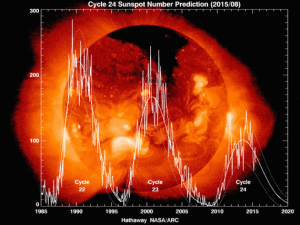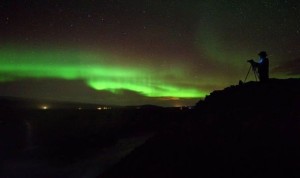We have been hearing about global warming, allegedly due to CO2 acting as a “greenhouse gas” since the 1980s. There is argument about this as water vapor is a stronger greenhouse gas.
“Water vapour is the most important greenhouse gas. This is part of the difficulty with the public and the media in understanding that 95% of greenhouse gases are water vapour. The public understand it, in that if you get a fall evening or spring evening and the sky is clear the heat will escape and the temperature will drop and you get frost. If there is a cloud cover, the heat is trapped by water vapour as a greenhouse gas and the temperature stays quite warm.
Does this mean the “97% of scientists are correct ? Nope.
My concern is that we are at the end of a Sunspot Cycle which is an 11 year cycle.

The solar cycle was discovered in 1843 by Samuel Heinrich Schwabe, who after 17 years of observations noticed a periodic variation in the average number of sunspots.[2] Rudolf Wolf compiled and studied these and other observations, reconstructing the cycle back to 1745, eventually pushing these reconstructions to the earliest observations of sunspots by Galileo and contemporaries in the early seventeenth century.
Following Wolf’s numbering scheme, the 1755–1766 cycle is traditionally numbered “1”. Wolf created a standard sunspot number index, the Wolf index, which continues to be used today.
The period between 1645 and 1715, a time of few sunspots,[3] is known as the Maunder minimum, after Edward Walter Maunder, who extensively researched this peculiar event, first noted by Gustav Spörer.
What happened with the “Maunder Minimum?” Maybe an Ice Age.
Valentina Zharkova, a professor of mathematics at Northumbria University in the United Kingdom, used a new model of the sun’s solar cycle, which is the periodic change in solar radiation, sunspots and other solar activity over a span of 11 years, to predict that “solar activity will fall by 60 percent during the 2030s to conditions last seen during the ‘mini ice age’ that began in 1645,” according to a statement.
Look at the chart of the solar cycles above. Doesn’t the one beginning 11 years ago look smaller at its peak ?
More evidence something is going on.
Aurora borealis or northern lights are among the most spectacular atmospheric displays. Called Aurora australis in the southern hemisphere they are visible evidence of the relationship between the sun and climate. In early days they called them Petty Dancers from the French petite danseurs. In England, they were also called Lord Derwentwater’s lights because they were unusually bright on February 24th, 1716, the day he was beheaded. A bad omen for him, but they were also an indicator of the bad weather and harvest failures of the period.
The Aurora is getting lower in latitude.

People have been known to catch a glimpse in Kent and Cornwall, but this is very rare.
Northern areas of England and Scotland are more likely to see the Aurora Borealis.
This is because these areas have a view of the northern horizon, the perfect place to spot the stunning lights.
They are getting more common in UK.
The current debate attracting more and more people is that we are cooling with the only question left as to the extent and intensity. Will it be weather similar to the cooler period coincident with the Dalton Minimum from 1790 – 1830? Alternatively, will it be colder with similar conditions to those by the early fur traders in Hudson Bay or those that spanned the life of Sir Edmund Halley? The appearance of Aurora in northern England suggests the latter, although I can predict who will protest this suggestion.
Next year will be the end of the current Solar Cycle. Then we will find out if the next will be a minimum.
Tags: energy policy, science